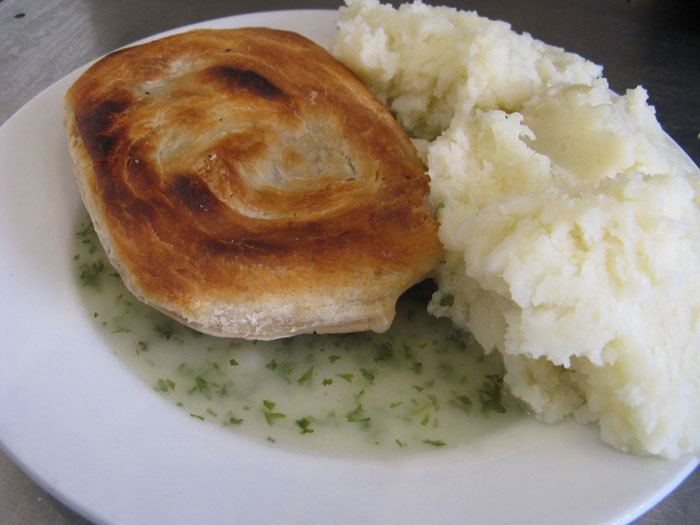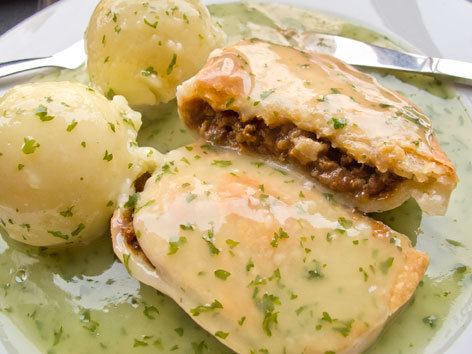 | ||
Similar Jellied eels, Bangers and mash, Steak pie, Steak and kidney pie, Mushy peas | ||
Broadway market f cooke eels pie and mash cockney london street food
Pie and mash is a traditional London working-class food, originating in London. Pie, mash and eel shops have been in London since the 19th century, and are still common in East and South East London and in many parts of Kent and Essex. The shops may serve stewed and/or jellied eels.
Contents
- Broadway market f cooke eels pie and mash cockney london street food
- East end pie and mash with liquor
- History
- Composition
- Shops
- Side dishes
- References

East end pie and mash with liquor
History

During the Victorian era, industrial air pollution tended to be worse in the east and south east of London because of the prevailing westerly wind, with the result that the East End was settled more by the working classes, while the western part of the city was home to higher social classes. The working class were poor and favoured foodstuffs that were cheap, in plentiful supply and easy to prepare.

The savoury pie had long been a traditional food, and its small handsized form also made it a transportable meal, protected from dirt by its cold pastry crust. European eels baked in a pastry crust became a common worker's meal since eels were one of the few forms of fish that could survive in the heavily polluted River Thames and London's other rivers at that time. Supply was plentiful through the late 1800s, particularly from the Dutch fishing boats landing catches at Billingsgate Fish Market. Adding cheap mashed potatoes made it a plate-based sit-down meal, and a sauce made of the water used to cook the eels, coloured and flavoured by parsley, made the whole dish something special.

Later, and for a higher price, mutton or inexpensive minced meat could be alternatively ordered as the pie filling. After World War II, as the eel supply dwindled and beef often became cheap and in far greater supply from overseas sources, minced beef became the more popular pie filling.

In recent years, the popularity of eel based pies again rose along with the propensity of people to investigate their roots and origins and the associated customs and cultures. However, since 2010, as revealed in a joint-study by the Zoological Society of London and the Environment Agency, the number of eels captured in research traps in the River Thames fell from 1,500 in 2005 to just 50 in 2010, meaning most eels used in Pie and Mash shops are now from the Netherlands and Northern Ireland.
Composition

The main dish sold is pie and mash — a minced beef and cold water pastry pie served with mashed potato. There should be two types of pastry used, the bottom or base should be suet pastry and the top short. It is common for the mashed potato to be spread around one side of the plate and for a type of parsley sauce to be present. This is commonly called eel liquor sauce or simply liquor (although it is non-alcoholic), traditionally made using the water kept from the preparation of the stewed eels. However, many shops no longer use stewed eel water in their parsley liquor. The sauce traditionally has a green colour, from the parsley. Sometimes a gravy is served instead (normally Oxo or Bisto).
Shops
Before shops became common, trading took place from braziers or carts, it was not until late Victorian times that shops began to appear. The first recorded shop was Henry Blanchard's at 101 Union Street in Southwark in 1844 which was described as an "Eel Pie House". The shops have become part of the local community and heritage of their area, for example, L. Manze in Walthamstow became Grade II listed by English Heritage in 2013 due to its architectural and cultural significance.
Traditionally, pie and mash shops have white tile walls with mirrors, and marble floors, tables and work tops, all of which are easy to clean. They give the shops - hardly ever called restaurants - a late Victorian or Art Deco appearance.
Because of the large number of pleasure boat steamer companies offering Sunday trips on the River Thames, many Eastenders used them to explore the more gentrified west of London. The result was that many also wanted their traditional foods of ale and pie and mash, resulting in the renaming of both a hotel that they frequently visited and the island on which it sat in Twickenham to Eel Pie Island in the early 1900s.
Side dishes
Jellied eels and cockles are other London specialities often sold in pie and mash shops, usually bought ready prepared from wholesalers. Chilli vinegar (vinegar containing pickled chilies), originating from the spice trade imports to the London docks, is also traditionally served with all these dishes. Prior to the introduction of chilies to the vinegar in recent years the vinegar of choice was a plain malt vinegar like Sarsons. Vinegar of choice was non brewed not malt. In recent years, some pie and mash shops have started to offer a broader selection of pies, including vegetarian and chicken versions, to serve a broader range of customers. Fruit pies (sprinkled with sugar) were already available in many shops as a dessert.
